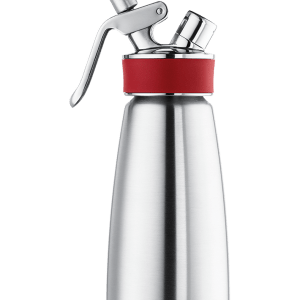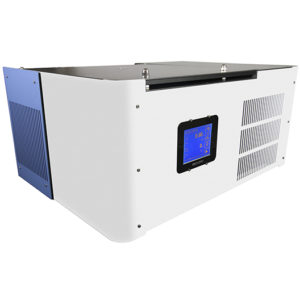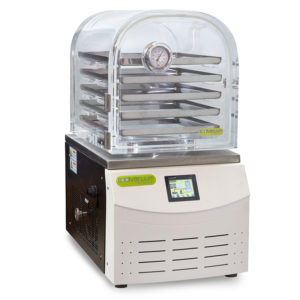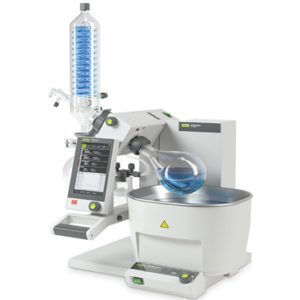The UP400St is suitable for various applications such as homogenization, emulsification, dispersion, deagglomeration and wet milling (particle size reduction), cell disruption and disintegration, extraction, degassing and sonochemistry.
934.23.95.80 | pedidos@toufood.com
With the Hielscher UP400St Powerful Ultrasonicator (400W, 24kHz), the Hielscher series of digital ultrasonic devices is extended with a powerful 400 watt ultrasound.
The new UP400St is the successor to the UP400S, one of Hielscher’s most popular laboratory systems.
Its high ultrasound power and robustness make the UP400St perfectly suited for use in demanding environments.
Equipped with a color touchscreen for easy control, integrated LEDs for sample illumination, plug-in temperature sensor, integrated SD card for automatic data logging as well as many other features, the UP400St convinces with its ease of use and reliability.
The UP400St is ideal for efficient and accurate sonication of large samples.
As our most powerful laboratory device, the UP400St is suitable for various applications such as:
homogenisation, emulsification, dispersion, deagglomeration and wet milling (particle size reduction), cell disruption and disintegration, extraction, degassing, as well as sonochemical processes.
With sonotrodes ranging in diameter from 3 to 40 mm, the device is suitable for sonication of sample volumes from 5 to 4000 ml.
In combination with a flow cell, approximately 10 to 50 liters per hour can be sonicated.
When used for sample preparation, the UP400St is primarily used for larger volumes.
It is suitable for the development of ultrasonic applications in the laboratory, but also in benchtop optimization, as well as for small quantity production.
The device’s functions and various accessories allow for different applications and the coverage of very wide parameter settings.
It can run continuously 24h/7d at full load and is good for processing up to 400L/h.
In general, the UP400St is used for sonication of volumes from 5.0 to 4000 mL.
Due to its robustness and its ability to operate 24/7, the UP400St can also be used for smaller quantity production.
Ultrasonics are powerful mixers and homogenisers whose application is not limited to the laboratory and industry.
For some years now, ultrasound has also been making its way into gourmet kitchens.
Prestigious star awarded gourmet restaurants, small gems of the finest gastronomy, cooking schools as well as amateur chefs use sonic sonicators to explore the effects of ultrasound in molecular cooking and create unique dishes.
Ultrasonic waves applied to solid-liquid mixtures are a powerful and efficient extraction method.
Try brewing your cup of cold brew coffee with ultrasound!
Depending on how strong you want it to be, add 1-2 teaspoons (or more) of ground coffee powder to a cup of cold water and stir.
Then remove the coffee powder by filtering it through coffee filter paper.
If you need coffee as an ingredient for cooking or baking, use it cold.
If you want to drink it, warm it up a little.
Ultrasound offers you the possibility to age wines, ciders, spirits and liqueurs instantly.
You can sonicate an acidic wine or a strong spirit to soften its taste or you can flavour the wine or spirit by sonicating it with, for example, oak shavings.
In addition to ageing, our ultrasonic cleaners are ideal for making alcoholic infusions.
Just add your flavouring ingredient, e.g. lavender, orange peel pieces, crushed chilli to your drink (e.g. vodka, white rum) and sonicate the mixture – preferably in an ice bath to control the temperature.
After sonication, solid particles are removed by straining.
Ultrasound is well known for its extraordinary extraction effects.
Put the herbs, leaves or flowers in the liquid you want to infuse (e.g. water, alcohol, oil).
To improve ultrasound extraction, it is recommended to macerate the plant material, as smaller particles are more affected by ultrasound.
Oil is an excellent carrier of flavours and therefore ideal for infusion with ultrasonically extracted flavours.
Add the ingredients whose flavours you wish to extract to the oil and infuse.
Suitable ingredients are, for example, raspberries, herbs, chillies or garlic.
Move the ultrasonic probe in the oil so that the parts of the plant are evenly affected by the ultrasonic waves.
Ultrasound is a proven technique for creating stable emulsions.
By shearing the droplets by ultrasonic cavitation down to micrometric and nanometric sizes, immiscible liquids such as oil and water are mixed.
Thanks to their excellent emulsifying properties, ultrasound is used in the preparation of vinaigrettes, dressings, sauces and gravies.
Mash the vegetables or fruit of your choice to a puree.
If the puree is too thick, you can add a little water, milk or oil.
Then sound the mash by moving the ultrasonic probe in the mixture to achieve a uniform treatment.
The ultrasound breaks the cells and releases all flavours, nutrients and sugar from them.
This results in an intense flavour and a thick, smooth texture.
As all natural sugar trapped in the cells is released by sonication, the addition of retail sugar or artificial sweetener can be completely avoided, which is especially important for smoothies and fruit purees.
Prepare crispy crisps using your ultrasonic probe-type fryer.
First, fry the freshly cut potato sticks in the hot oil.
In the second step, blast the fries at medium intensity.
Be sure to stir the fries in the oil from time to time so that the ultrasound reaches the surface of all the fries.
Ultrasonic cavitation creates unseen fissures and cracks the potato cells to make starch available.
The extracted starch makes the potatoes crispier.
After sonication, fry the potatoes for a few seconds until golden brown and crispy.
Remove them from the frying oil and drain on a paper towel.
Ultrasonics are ideal for mixing thickeners and stabilisers such as hydrocolloidal xanthan gum and guar gum in recipes.
As ultrasound creates strong shear forces, even powders that are hardly miscible and tend to clump together can be mixed homogeneously in liquids.
Xanthan gum and guar gum thicken very quickly, which makes it even more difficult to mix them in a formulation.
Ultrasonic mixing produces a very fine and homogeneous mixture, so that the xanthan or guar gum powder can unfold all its properties.
This helps you to use less thickening rubber powder.
Add the xanthan or guar gum gradually and by sonication to your sauce.
Move the ultrasonic probe in the beaker to ensure that the powder is evenly sonicated and well mixed with the liquid.
When you switch off the ultrasonic device, you can immediately see the thickening effect.
If you want to create a xanthan foam, choose a probe with a larger tip diameter and move the ultrasonic probe up and down in the liquid and xanthan gum suspension.
Whenever the probe is on the surface (almost on the surface of the liquid) of the liquid, air bubbles will be trapped, so that a light foam will form.
Modern kitchens and bars are often equipped with spectacular tools, which have their roots in the laboratory.
Chefs and bartenders use rotary evaporators, vacuum chambers and sous-vide equipment.
Ultrasonic homogenisers have also quickly found their way into kitchens and bars.
Ultrasonic waves make it possible to extract and infuse beverages with new flavors, age spirits and wines, and emulsify oil and water mixtures in a matter of seconds.
This rapid infusion technique opens a new field to create new taste experiences and flavor combinations.
In particular, botanicals such as herbs, spices and wood are very often used.
With an ultrasonic blender, a whisky can be infused with oak shavings and thus be converted into a whisky with a flavour profile as if it had been aged in casks for several years.





TÖUFOOD is a complete line of products of exceptional quality, developed by GASTROCULTURA MEDITERRÁNEA SL, which allows the most well-known techniques of modern cuisine to be put into practice. Innovative recipes can be easily realised, bringing excitement and surprise to dishes, offering a stimulating and memorable culinary experience.